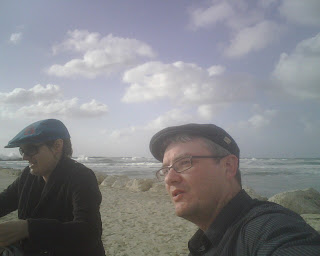Yad Vashem and Pointed Editorial Comments

(Credit to this site for the photo—I would not have been allowed nor would I have taken photos inside the museum. Learn more about Yad Vashem.)
How do you write about emotions, impressions and thoughts when you visit a Holocaust memorial? The first time I visited any place with any information about the Holocaust was a week before I went to
I like neither the feeling nor the reality of ignorance, so I have made up for these educational gaps as much as I was able to in the meantime, as much as anyone is able, which is partially the point of the whole post—how much are any of us really able to learn about the Holocaust? How can any exhibit or museum or book or film or play or lecture or even a lifetime of these combined give any of us the smallest fraction of the sum total of the whats and the whys? A little food for thought on how impossible this task is: A quote by Stanley Kubrik that is posted in Yad Vashem regarding Schindler’s List, a film I have heard more than one person call a definitive Holocaust film, states: “Think that was about the Holocaust? That was about success, wasn't it? The Holocaust is about six million people who get killed. 'Schindler's List' was about six hundred people who don't." That's perspective.”
Taking this impossibility as a jumping off point let me focus then on only one small thing. Now several days after my first visit, I realize that I am more impressed with the information in hindsight than I was in the moment – in the moment it was simply too much. I walked through quickly, reading little in detail, intending to get a feel for the totality of the exhibits and then return at a later date to focus on what I felt I needed to focus on. The one thing that stopped me in my tracks and brought me to tears, however, was a shoe insert. A letter in German to a book seller next to the shoe insert read roughly, “I have procured a large amount of real parchment (donkey skin) of high quality. The writing on one side can be easily scraped off with a little water . . .” etc. etc. Of course the “writing” was Hebrew and the parchment that the man was so excited about was parchment from the Torah Scrolls looted from Synagogues. And such practical items were made out of the “parchment.” There were day diaries and the backs of drums and stringed instruments, and so much else, all with the Hebrew so clearly showing that with a yad and a blessing I could have chanted from them.
I debrief with my wife almost daily on the phone, and after I returned from Yad Vashem we had an intense discussion on the nature of Holocaust education and basic “Jewish” awareness—that is, awareness of Judaism outside of Judaism. You see, the parchment seller represents tragedy and pathos simultaneously—the wanton destruction, theft, vandalism, disregard and mockery of sacred Jewish symbols is and was truly tragic. Moreover, I am sure that the SA and SS and partisans that looted the Synagogues knew that these were sacred objects, and the mockery in all its forms, by all historical accounts, was meant to draw blood and dehumanize in the worst way. Yet the parchment seller’s letter does not represent mockery. After reading the entire letter in the original language several times, I am convinced that he was thrilled to have found parchment, and had no clue as to the sacred nature of the “wares.” I am not excusing the cycle of horror here – anyone that knows me knows much better. There is an argument to be made here, however, that those of us in positions of Jewish leadership, present or future, might want to open up discussions among ourselves on how we can educate our larger communities on the beauty and value of our sacred symbols. Should I not expect of my Christian neighbors the same respect for a Torah scroll as they should expect from me for a communion table? It is easy to mock willfully or through ignorance that which is other, but much harder to attack that which is part of community. Listen, I know much more these days about the history of the Holocaust, and I know that my suggestion above is an absurdity when one knows the reality of “friends” and “neighbors” in many parts of
The Danish police and coast guard also took sides with the oppressed by refusing to assist in the manhunt. Not to mention the Wehrmacht soldiers, some of whom looked the other way - moved by either compassion or bribes.
To make their escape, many refugees were driven to the coast in ambulances belonging to the hospital. Local fishermen agreed, for a price, to transport them to Sweden. But they weren't safe yet. Successfully completing the two-mile boat trip without being intercepted by German patrol boats was not easy . . . Over the course of a few days, more than 7,000 Danish Jews reached safety in Sweden. Only 481 were captured and sent to a Nazi prison at Theresienstadt.”
Source -- http://www.auschwitz.dk/Denmark.htm
Why was it so different there? The fact that the Jews there were integrated is somewhat meaningless, as so were Jews in other parts of

Comments
Personally every time you talk about what the Danes did to protect their Jews (and others, I assume) from the Nazis I feel moved to make a pilgramage there and thank them--somehow! We'll be living in Berlin, let's make it happen. They should get some of our tourist dollars, too.
love always,
Sandra